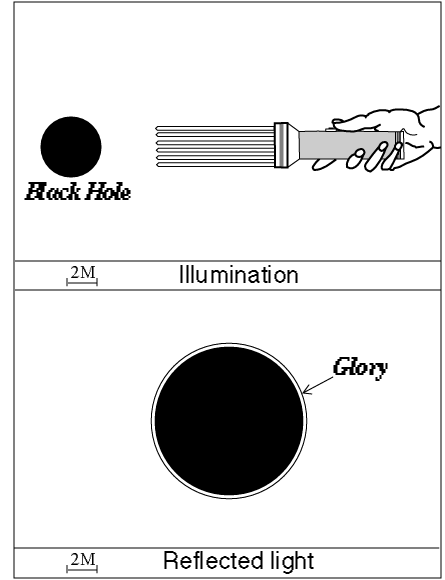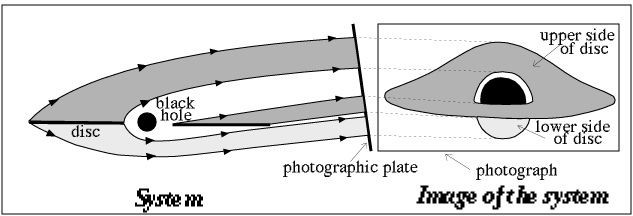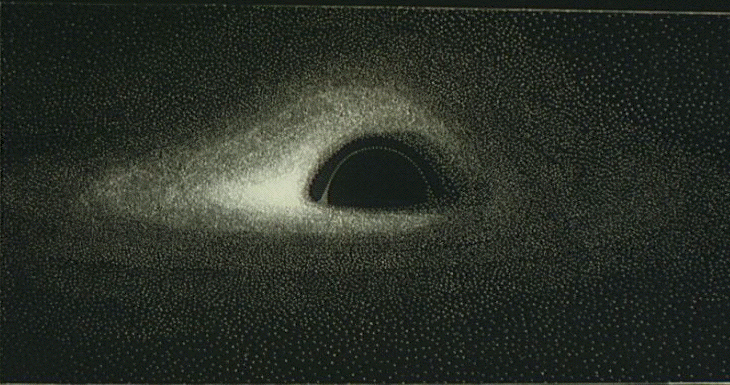


This is chapter 10 of J.-P. Luminet's book "Black Holes", Cambridge University Press (1992).
To have more, click here
"The centre of the black hearth, of setting suns on the shore: ah! wells of
magic."
Arthur Rimbaud, Illuminations
A question of lighting
One of the best ways of representing a body is by its image, by photographing it. Can we imagine photographing a black hole?
The question is not as ridiculous as it seems, even though by definition a black hole does not emit light. This is true of all bodies which are sufficiently cold that they do not have their own detectable source of radiation. Everything has to be illuminated for us to able to see it. In the night sky, the planets, whose cores do not generate thermonuclear energy, would remain invisible if their surfaces did not reflect the Sun's light(1).
In this respect what is true for a planet is also true for a black hole. A non-illuminated black hole would remain invisible, but with suitable lighting it is possible to obtain an image. A blackhole can be photographed under lights!
Every natural body absorbs and reflects electromagnetic radiation in some way. The experiment illustrated in Figure 30 uses a parallel beam of light to illuminate several 'ideal' bodies, and to observe the reflected light in a direction perpendicular to the incident direction. The type of image received depends on the nature of the body and how it reacts to electromagnetic waves.
In the case of a perfectly black body (for example a sphere covered with perfectly absorbing black paint) all the light rays are absorbed, and in the absence of any reflection the observer will see absolutely nothing of the sphere (Figure 30a).
In the case of a matt surface (such as the Moon and the planets), the light is 'isotropically' reflected, that is, with the same intensity in all directions. Consequently at each point on the surface a single light ray may be deviated exactly 90deg. with respect to the incident direction and reach the observer. The result (Figure 30b) shows the familiar image of the half Moon.
The third example concerns a perfectly reflecting metallic sphere. This time a single point on the surface deviates an incident light ray by 90deg. and sends it to the observer. The image of the sphere (Figure 30c) is reduced to a unique spot of light, situated at a distance of 0.707 times the real radius of the sphere.
The final case is that of a black hole. The essential difference from the preceding examples is that a black hole is not a tangible hard surface against which light rays can strike and be reflected. It is the black hole's gravitational field which deviates the light rays. The black hole's sphere of influence is not therefore a single sphere - the event horizon - but extends to infinity. The trajectories of light rays are not altered by the impact with a surface, but are curved by the gravitational field. In the experiment where it is illuminated, the black hole's gravitational field deviates several light rays towards the observer. The image of the black hole consists of a series of illuminated spots (Figure 30d). On the left, at 2.96 times the Schwarzschild radius of the black hole, the 'primary' image is produced by light rays which have been deviated by 90deg.. On the right, 2.61 times the Schwarzschild radius the 'secondary' image is produced by light rays which have been deviated through another half circle (a total of 270deg.). The complete calculation of the geodesics of the Schwarzschild space-time corresponding to the trajectories of the light rays shows that there is an infinity of images; the third one corresponds to light which has been deviated by 450deg., and so on adding a half turn each time. However, in practice, the images of order higher than two have such a low intensity and are so close to the primary and secondary images that they cannot be resolved.
We can therefore conclude that among the various celestial bodies which are not intrinsically bright, black holes are far from being the darkest. They are easier to detect than a black painted sphere or a highly reflective sphere!

|
Figure 30: The illumination of four types of bodies.
|
The black hole in glory
A variant on the preceding experiment consists of illuminating a black hole and observing the light reflected back in the same direction. The result is shown in Figure 31.
The image of the actual black hole is magnified to 2.6 times its real diameter. This is because a large part of the incident beam is captured by the black hole: not just the radiation which directly strikes the event horizon but also that which passes within 5.2 M of the centre (the true radius of the black hole is equal to 2 M). The black disc appears to be surrounded by a series of concentric light rings. The final result is like the glory effect, well known in traditional optics: when sunlight is scattered by innumerable water droplets in mist, it is sometimes possible to see in reflection the shadow of one's own head surrounded by brilliant rings of light centred on the line of sight.
In the case of black holes with a glory effect, only the outer ring would be visible, as it is not possible to resolve the rings of higher orders.

|
Figure 31: The halo of a naked black hole. A black hole is illuminated by a parallel beam of light and one observes the returning light, formed of rays deviated 180deg. by the black hole's gravitational field.
|
Heads and Tails
The experiments which have just been described are more than an intellectual exercise, because if black holes really exist then there is a good chance that they will be illuminated by a natural light source.
For a black hole or a planet the most obvious form of lighting is a star. This star could for example be bound to the black hole in a binary system. Although such systems may be common throughout our Galaxy, the corresponding black holes would be impossible to detect by this effect as the image of the black hole by reflected light would be drowned in the intense light of the direct image of the star itself.
A much more interesting situation from an observational point of view is when the source of light comes from a series of rings of matter in orbit around the black hole. In the final part of the book, I shall give arguments for the belief that a number of black holes are surrounded by such structures, which are called accretion discs. Saturn's rings are an excellent example of an accretion disc; they consist of amalgamated pieces of rock and ice, whilst those of a black hole consist of hot gas(2). The gases fall slowly into the black hole, like water in a whirlpool. As the gas falls towards the black hole it becomes hotter and hotter and begins to emit radiation. This is a source of light: the accretion rings shine and illuminate the central black hole.
Figure 32 shows the contours of a circular disc surrounding a spherical black hole. The image was photographed at a great distance, in a direction which was slightly inclined above the plane of the disc. The strong curvature of space-time near the hole manifests itself as a distortion of the apparent image of the disc. In the case of Saturn's rings, this is reduced to a series of ellipses because they are seen through a practically flat space-time. Here, the image is split into two. The primary image is formed by light rays emitted from the upper side of the disc, and deviated by less than 180 degrees. The first surprise is that all of the upper side of the ring in front and behind the black hole is visible, including the portion which would 'normally' be hidden in an uncurved geometry (Saturn's rings observed from the Earth are partially hidden by the planet's disc).
Even more surprising is that the curvature of space-time around the black hole enables us to observe the lower side of the rings. This is the secondary image. So it is possible to observe both the upper and lower sides of the accretion disc!
In fact there is an infinity of images, because the light rays emitted by the disc can travel any number of times around the black hole before escaping from its gravitational field and being observed by a distant astronomer. The primary image shows the upper side and the secondary image shows the lower side, the third image shows the upper side again, and so on. However, higher order images are not optically interesting because they are stuck to the edge of the central black disc, the latter representing an expanded image of the actual black hole.

Figure 32: Optical distortions near a black hole.
We imagine a black hole surrounded by a bright disc. The system is observed
from a great distance at an angle of 10deg. with respect to the plane of the
disc. The light rays are received by a photographic plate. Because of the
curvature of space-time in the neighborhood of the black hole, the image of the
system is very different from the ellipses which would be observed if an
ordinary star replaced the black hole. The light emitted from the upper side of
the disc forms a direct image and is considerably distorted so that it is
completely visible. The lower side of the disc is also visible as an indirect
image caused by highly curved light rays.
A black hole is illuminated by a parallel beam of light and one observes the
returning light, formed of rays deviated 180deg. by the black hole's
gravitational field.
Photographing a black hole
These illumination experiments, although idealised, at least show how a black hole, through its gravitational field, acts on radiation as a sort of lens which multiplies images of a single unique source. Let us now consider a more realistic situation. Rings of matter around celestial bodies have been intensively studied over the last twenty years because they are related to a large number of astronomical phenomena: the planets (Saturn, Jupiter, Uranus and Neptune), and binary star systems where one of the partners is a condensed star (white dwarf, neutron star and black hole). The gravitational field around a black hole sucks in the overflowing gas of its companion, stores it in the accretion disc and slowly consumes it.
Detailed models of accretion discs explain the high energy radiation emitted by some binary star systems such as Cygnus X-1. On a much greater scale, the high luminosity of the nuclei of certain galaxies and quasars can also be explained by the flow of matter into a black hole of several million or several billion solar masses. A detailed discussion of the role of black holes in these various astronomical phenomena will be the subject of the last part of this book. For the moment it is enough to know that when the flow of matter into a black hole is not too great, it can form a very thin accretion disc, whose emission of radiation can be accurately calculated.
In 1978, I reconstructed the photographic appearance of a spherical black hole surrounded by a very thin gaseous disc, by using a computer to calculate the trajectories of light rays in the Schwarzschild space-time (Figure 33). In a thin disc the intensity of radiation emitted from a given point on the disc depends only on its distance from the black hole. The reconstituted image is therefore universal, that is, it is independent of the mass of the black hole and the flow of gas into it. It could as easily represent a black hole 10 kilometres in diameter or one that was as large as the Solar System and swallowing interstellar gas.
As in Figure 32, the upper side of the disc is completely visible. However only a small part of the lower side is observable. In a realistic situation the gaseous disc is opaque; therefore it absorbs the light rays it intercepts. It follows that a major part of the secondary image - showing the lower side of the disc - is occulted by the primary image; the very deformed visible part is at the edge of the black hole.
No radiation comes from the region between the black hole and the inner edge of the disc. The properties of the Schwarzschild space-time forbid the accretion disc from touching the surface of the black hole. The almost circular orbits of the gas in the disc can be maintained only down to a critical distance of three times the Schwarzschild radius. Below this the disc is unstable; the gas particles plunge directly towards the black hole without having enough time to emit electromagnetic radiation.
The main characteristic of a 'photograph' of a black hole is the apparent difference in luminosity between the different regions of the disc. The maximum brilliance comes from the inner regions closest to the horizon, because it is here that the gas is hottest. However, the apparent luminosity of the disc is very different from the intrinsic luminosity. Apart from the geometric distortion of the circular rings, the radiation picked up at a great distance by a photographic plate is frequency - and intensity - shifted with respect to the emitted radiation. There are two sorts of shift effects. There is the Einstein effect, which has been mentioned several times, in which the gravitational field lowers the frequency and decreases the intensity. In addition there is the better known Doppler effect, where the displacement of the source with respect to the observer causes amplification as the source approaches and attenuation as the distance increases(3). In this case the Doppler effect is caused by the disc rotating around the black hole. The regions of the disc closest to the black hole rotate at a speed approaching that of light, so that the Doppler shift is considerable. The sense of the rotation of the disc is such that matter recedes from the observer on the right hand side of the photograph and approaches on the left hand side. As the matter recedes, the Doppler deceleration is added to the gravitational deceleration, explaining the very strong attenuation on the right-hand side. In contrast, on the left-hand side the two effects tend to cancel each other out, so the image more or less retains its intrinsic intensity.

Figure 33: The appearance of a distant black hole surrounded by an accretion
disc.
The image was calculated by a computer. As in the preceding image, the system
is seen from a great distance, inclined at an angle of 10deg. above the plane
of the disc. The image is realistic in the sense that it takes account of the
physical properties of the gaseous disc.
--------------------------------------------
Notes:
(1) Jupiter, the largest planet in the Solar System, possesses an internal source of energy. By contracting slightly, its core transforms atomic hydrogen into 'metallic' hydrogen forming a solid lattice like ice. This 'phase transition' liberates a small amount of energy, providing Jupiter with its own luminosity, which is just greater than that coming from the reflection of solar light.
(2)Another important difference is that the accretion disc of a black hole is continually being supplied with gas, whilst that surrounding Saturn is the remnant of the primordial Solar System.
(3) Also see Chapter 16.